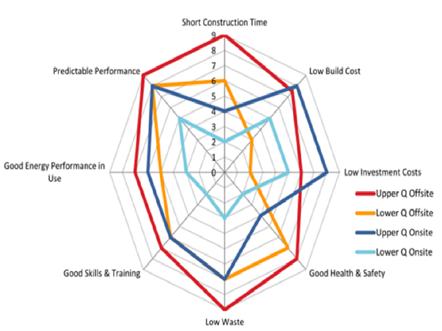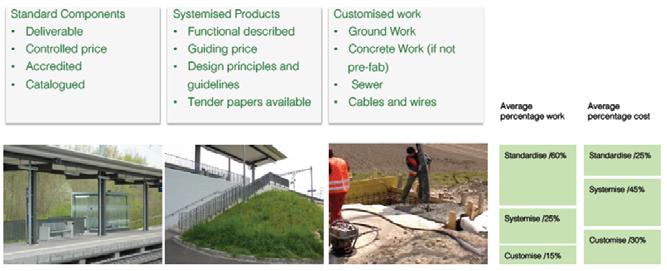
7 minute read
Theroleoffsitecan playin overcoming the Valuechallenges ofCOVID-19 Delivering
The role offsite can play in overcoming the challenges of COVID-19 & Delivering Value
Offsite offers both the means to mitigate the effects of the restrictions imposed due to COVID-19 and opportunity for improved efficiencies in construction. The benefits can be industry and project wide. We set out below a value led approach based on the CLC 3-point strategy COVID-19 response and also the methods by which offsite can mitigate the impacts of COVID-19 based on a risk based approach
Studies show that that the characteristics of offsite, by its nature, meet a number of the CLC aspirations.
1 5
Figure 5.1: Characteristics of offsite construction (Offsite Housing Review, May 2013, CIC)
Cost certainty Higher productivity rate to a lower cost Reduced number of defects Benefits the prs due to the speed of revenue Circular economy with systems designed to be disassembled Reduced overall manufacture and assembly time Reduced risk of delays Greater programme time certainty
Conventional construction has a larger fatal rate and major injury rate than the manufacturing industry The number of in site hours can be reduced by 60%-80% which reduces the occurrences of injury Source: RIBA Plan of Work 2013 Designing for Manufacture and Assembly (2016). Whilst established practices have probably prevented offsite methods being more prevalent, the current crisis creates the demand and environment for new approaches. Based on these characteristics the ability of offsite to meet current demands and add value at all three stages are summarised below. These are presented in terms of requirements of the CLC roadmap and opportunity.

Reducing the number of deliveries to the site, and the number of site staff, an offsite project can reduce pollution and road congestion up to 20% Noise is also minimised as more activities are done offsite Reduction of waste produced onsite Less risk of pollution to
Delivering value
local watercourses
Stage 1: Restart: increase output, maximise employment and minimise disruption (0-3 months).
Requirement
Identify opportunities for systematising, standardising products or pre-assembling elements common to multiple projects.
Opportunity
Review new project requirements and include performance specifications that encourage designers and suppliers to incorporate higher productivity MMC. Examples of such requirements could include the following:
Action Minimise concrete, screeds or plaster).
No wet trades above foundations
Waste needed to be removed from site
Working at height (e.g. by pre-assembling large structural elements and services that are at or above ceiling level) The number ofsite deliveries
Hot trades (roofmembranes may need to be welded on site)
Reduce the whole life carbon footprint ofthe facility (embedded + in use + decommissioned) Benefits
Faster project delivery.
More space to work in. Less disposal costs. Better sustainability. Improved safety. Reduced equipment costs. Higher productivity.
Less community disruption and pollution. Fewer personnel needed on site. Less ofsite required for storage and vehicle movements / cleaning. Less risk ofdamage to materials. factories. project in the context ofthe facility’s cradle to grave life cycle.
Less risk offire or burns. Improved quality assurance.
Contribute towards zero/reduced carbon targets.
Maximise benefits. Improved delivery predictability.
Factory based assembly
In-factory commissioning ofbuilding management systems and associated equipment
Routine quality assurance. Higher labour productivity. Safer working. More inclusive and better working environment. Sustainability Saves time on site. Can reduce a critical path activity. How
No time required for drying and curing (e.g. of Less space required for unproductive uses. Less vehicle movements. Less landfill. Less risk ofdangerous falls. Removed need for safety equipment. Working in factory conditions. More activity offsite.
By avoiding welding etc. on site. Such processes are more efficiently managed in Consider using new low carbon materials and design solutions at an early stage ofthe
Table 5.1: Opportunities of Offsite to Deliver Value
Better defined work instructions. More controlled processes. Less risks (e.g. from the weather).
Apply systems engineering methodology.
Stage 2: Reset: Drive demand, increase productivity, strengthen capability in the supply chain (3-12 months)
Requirement • Publish a strategy to benefit from systematised, standard products, and pre-assembled elements in future projects. Et parisciis aut faccusa
Standard Components
Deliverable Controlled Price Accredited Catalogued Systemised Products
Functional described Guiding Price Design principles and guidelines Tender papers available Customised Work

Ground work Concrete Work (if not pre fab) Design principles and guidelines Sower Cables and wires Average percentage work Standardise /60%
Systemise /25%
Customise /15% Figure 5.3: An example of standardised components and systematised products (courtesy of schockguyan). Average percentage cost Standardise /25% Systemise /25%
Customise /30%
Opportunity • Respond to defined client value parameters such as:
Outcome Awider climate change response policy
Maximising building footprint on site
Speed to opening all or part of the facility for business Business operations continuity
Minimising impact on neighbours
A holistic analysis of building design and an optimised construction rhythm
How Consider embodied carbon as well as in use performance. See figure 6 below. Reducing logistics, welfare, site scaffolding space requirements office
Design for manufacture, assembly commissioning. Increase offsite content. and
and
Avoid closing or restricting facilities, e.g. by avoiding use of scaffolding in operational areas. Use of mobile cranes at night, reduce installation times through exploiting modular solutions etc.. Reduce the number of deliveries and noisy or dusty activities. Take more work offsite. Package and co-ordinate work packages so that they may be synchronised, e.g. erection of a steel framed bay / its roof / its floor / its cladding.
Table 5.2: Opportunities of Offsite to Deliver Value

Figure 6: Embodied Carbon of UK Cements vs an example AACM
Stage 3: Reinvent: Transform the industry, deliver better value,
Requirement A different approach to procurement involving:
Action Supplier (designer / integrator / contractor) selection based upon lean construction capability maturity Demonstration by designers, integrators and main contractors of real understanding of supply chain capabilities Demonstration that optimum construction methods are actually being delivered on site the contractors. productivity.
Contracts designed to drive improved performance and shared benefits from productivity improvement demands over time
Implementation of proactive, demanding, supplier development programmes Creating robust evidence for clients that need to comply with public procurement rules demonstrating that they are receiving value for money and continuous improvement in projects
Managing risk and opportunities more collaboratively (e.g. using a single professional indemnity insurance policy and improvements’ benefits sharing for the project team as a whole) Whole life cost analysis that transcends the capital vs revenue budget divide and truly reflects the holistic design, MMC and realistic in use case assumptions. Use of open data standards that allow the exchange of information across multiple software applications, across many trades, and Outcome More efficient project delivery
Projects can be designed for manufacture and assembly.
Higher productivity. Better quality. Lower cost.
Better alignment of stakeholders’ objectives in the medium term resulting in better client value delivery and improved profitability for Real, sustained, continuous construction supply chains. improvement of
Less risk that public procurement will default to tendering projects to satisfy regulators and avoid legal challenges to procurement processes whilst enabling construction supply chains to focus on improving value and up and down the supply chain.
Better decision making within projects. Lower cost solutions to problems. Less litigation. More collaboration. Ultimately lower insurance costs, once the insurance industry can understand the benefits. Clientsbenefitfrom reducedcostofownership. Less resources are consumed in the long run.
Reduced data management costs. Faster communication and analysis. More informed decision making. Improved project delivery.
Table 5.3: Project Procurement Management Opportunities & Outcomes
Opportunity
Overcoming Risk
Offsite techniques can mitigate many of the delivery risks and overcome impacts of COVID-19.
Generally 50% higher productivity Transport reduced Works generally travel to non-city centre sites; fewer site staff; easing public transport issues Smaller stand-alone constant teams Better control of PPE Ability to set up social distancing work practices Easier to stagger work with less impact on residential areas Ability to protect supplies and components
Construction Risk Safe Working affects access and team working Mitigation
• •
Locally available resources Use ofcollaborative technology
Interruption ofsupply
Interruption to Construction
Legislative changes to design require construction changes requirements Library of simple repeatable details allows multiple sourcing Pre-manufacture approach combined with early procurement allows creation of time related buffer stocks to the extent needed to protect just in time deliveries
Preparation ofsafe working protocols Offsite manufacturing
Possible changes assessed for impact Design kept flexible.
Table 5.4: Project Risk & Mitigation Measures
Et parisciis aut faccusa





